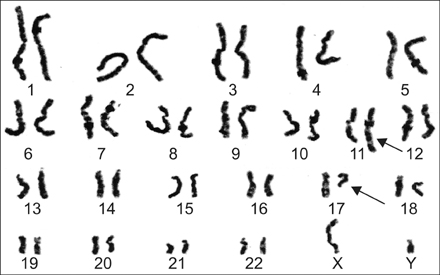Korean J Hematol.
2012 Sep;47(3):229-232. 10.5045/kjh.2012.47.3.229.
ZBTB16-RARalpha variant of acute promyelocytic leukemia with tuberculosis: a case report and review of literature
- Affiliations
-
- 1Department of Pathology, Government Medical College and Hospital, Chandigarh, India. dhimandrpratibha@yahoo.com
- 2Department of Medicine, Government Medical College and Hospital, Chandigarh, India.
- KMID: 2251959
- DOI: http://doi.org/10.5045/kjh.2012.47.3.229
Abstract
- A 23-year-old male presented with pulmonary tuberculosis and swelling of both lower limbs. He was put on antitubercular treatment. Hemogram showed mild anemia and Pseudo Pelger-huet cells. The bone marrow (BM) examination showed 52% promyelocytes with regular round to oval nuclei, few granules and were positive for CD13 and CD33, and negative for HLA-DR. Cytogenetic analysis of the BM aspirate revealed an apparently balanced t(11;17)(q23;q21). Final diagnosis rendered was acute promyelocytic leukemia (APL) with t(11;17)(q23;q21); ZBTB16/RARA. APL is a distinct subtype of acute myeloid leukemia. The variant APL with t(11;17)(q23;q21) cases that are associated with the ZBTB16/RARA fusion gene have been reported as being resistant to all-trans-retinoic acid (ATRA). Therefore, differential diagnosis of variant APL with t(11;17)(q23;q12) from classical APL with t(15;17)(q22;q12); PML-RARA is very important. Here we have discussed the importance of distinct morphology of variant APL and also significance of rare presentation with tuberculosis.
Keyword
MeSH Terms
Figure
Cited by 1 articles
-
Molecular methods for genomic analyses of variant PML-RARA or other RARA-related chromosomal translocations in acute promyelocytic leukemia
Min Jin Kim, John Jeongseok Yang, Claus Meyer, Rolf Marschalek, Tae Sung Park
Korean J Hematol. 2012;47(4):307-308. doi: 10.5045/kjh.2012.47.4.307.
Reference
-
1. Soignet SL, Maslak PG. Greer JP, Foerster J, Rodgers GM, editors. Acute promyelocytic leukemia. Wintrobe's clinical hematology. 2009. 12th ed. Philadelphia, PA: Lippincott Williams & Wilkins;1937–1938.2. Grimwade D, Biondi A, Mozziconacci MJ, et al. Characterization of acute promyelocytic leukemia cases lacking the classic t(15;17): results of the European Working Party. Blood. 2000. 96:1297–1308.3. Sainty D, Liso V, Cantù-Rajnoldi A, et al. A new morphologic classification system for acute promyelocytic leukemia distinguishes cases with underlying PLZF/RARA gene rearrangements. Blood. 2000. 96:1287–1296.4. Chandra J, Marwaha RK, Marwaha N, Kumar A, Mothanty D. Pancytopenia and leukemoid reactions in tuberculosis. Indian J Pediatr. 1986. 53:665–667.
Article5. Dreskin SC, Iberti TJ, Watson-Williams EJ. Pseudoleukemia due to infection. A case report. J Med. 1983. 14:147–155.6. Twomey JJ, Leavell BS. Leukemoid reactions to tuberculosis. Arch Intern Med. 1965. 116:21–28.
Article7. Coburn RJ, England JM, Samson DM, et al. Tuberculosis and blood disorders. Br J Haematol. 1973. 25:793–799.
Article8. Wang ZY, Chen Z. Acute promyelocytic leukemia: from highly fatal to highly curable. Blood. 2008. 111:2505–2515.
Article9. Kang LC, Smith SV, Kaiser-Rogers K, Rao K, Dunphy CH. Two cases of acute myeloid leukemia with t(11;17) associated with varying morphology and immunophenotype: rearrangement of the MLL gene and a region proximal to the RARα gene. Cancer Genet Cytogenet. 2005. 159:168–173.
Article10. Licht JD, Chomienne C, Goy A, et al. Clinical and molecular characterization of a rare syndrome of acute promyelocytic leukemia associated with translocation (11;17). Blood. 1995. 85:1083–1094.
Article
- Full Text Links
- Actions
-
Cited
- CITED
-
- Close
- Share
- Similar articles
-
- Promyelocytic sarcoma of the sternum: a case report and review of the literature
- A variant acute promyelocytic leukemia with t(11;17) (q23;q12); ZBTB16-RARA showing typical morphology of classical acute promyelocytic leukemia
- A Case of Promyelocytic Leukemia with Basophil-like Granules
- A case of microgranular variant of acute promyelocytic leukemia with strong positive reaction in nonspecific esterase stain
- All-trans Retinoic Acid induced Myositis in a Patient with Acute Promyelocytic Leukemia





